What’s Worth Watching: Lt. Uhura, aka Nichelle Nichols, is a ‘Woman in Motion’

Best-known for playing chief communications officer Lt. Uhura on “Star Trek: The Original Series,” Nichelle Nichols took the show’s mission to heart long after the final episode.
“Woman in Motion” tells the story of Nichols’ mission to diversify the space program, to make certain that exceptional men and women of any background would have their chance “to boldly go” where no one had gone before.
In her early show business career, Nichols went from dancing ballet to touring with Duke Ellington, and when a gig brought her through California on her way to Hawaii, she fell in love with Los Angeles and quickly did everything she could to return.
Back in L.A., Nichols landed a part on Gene Roddenberry’s “The Lieutenant.” The episode she starred in focused on racial discrimination and other problems in the military; it was so controversial that the network refused to air it.
Determined to get those stories on television, Roddenberry set about finding a new way to go about it.
The solution was “Star Trek,” and Roddenberry planned it with Nichols in the back of his mind. But, when he first brought in Nichols to audition, his team had her read for Spock because Uhura wasn’t written yet.
In that first audition, she inspired them to add a character to “the bridge crew,” and they hired her on the spot.
The diversity of the cast was groundbreaking. And the fact that Lt. Uhura, a Black woman, and Lt. Sulu, an Asian American man, were part of the command team was especially so.
Unfortunately, whatever Roddenberry’s original plans had been for Uhura, the role was constantly being diminished, “Even in the enlightened 23rd century of Gene’s imagination, a strong, independent Black woman was not welcome,” Nichols wrote in her autobiography, “Beyond Uhura.”
After a few too many episodes stuck on the bridge with her lines amounting to little more than “hailing frequencies open, Captain,” Nichols was ready to quit.
“She’s the chief communications officer, and she can’t talk?” Nichols said.
But then one evening at an NAACP event, she met a particularly enthusiastic fan: Dr. Martin Luther King Jr.
He told her that “Star Trek” was the only show he let his children watch. And when she told him she was planning on leaving the show, he begged her not to do so.
“He said you don’t understand the effect you’re having not only on Black people, not only on young women, but on everybody,” Nichols recalled. “Everybody’s mind and attitude is changed immeasurably simply because you are there.
“So I stayed, and I never regretted it.”
When the show was canceled, “Star Trek” conventions took off on an unprecedented scale. They had gained so much traction that NASA started sending scientists to speak.
At one of these events, Nichols met Dr. Jesco von Puttkamer, and, through him, she was invited to join the board of directors of the National Space Institute. During her first speech to the group, she looked out over a sea of white, mostly masculine faces and asked, “Where are my people?”
“Here I was, involved in projecting a future of where our space program could take us, and I wanted to be there, not in fantasy, not in 300 years from today, but now,” Nichols said.
When she visited NASA headquarters, she found a surprising amount of diversity among the scientists working behind the scenes. But the astronaut core was still solidly white and male, and NASA wanted to do something about it.
Nichols told them they would need someone to recruit who people of color would trust, and NASA said, “How about Lt. Uhura?”
With a little convincing and a few concessions, she dove right into the job.
After a punishing media tour full of radio ads, talk show appearances and endless college campus appearances, Nichols brought NASA more candidates than they knew what to do with, as the campaign had worked.
Nichols signed up for less than one year of recruiting, but, today, unsurprisingly, she’s still at it.
“Woman in Motion” is available for purchase on Apple TV.